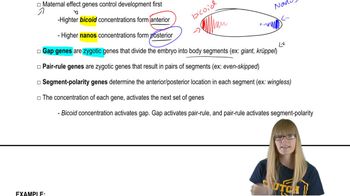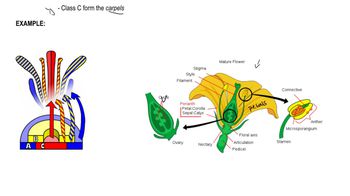Table of contents
- 1. Introduction to Genetics51m
- 2. Mendel's Laws of Inheritance3h 37m
- 3. Extensions to Mendelian Inheritance2h 41m
- 4. Genetic Mapping and Linkage2h 28m
- 5. Genetics of Bacteria and Viruses1h 21m
- 6. Chromosomal Variation1h 48m
- 7. DNA and Chromosome Structure56m
- 8. DNA Replication1h 10m
- 9. Mitosis and Meiosis1h 34m
- 10. Transcription1h 0m
- 11. Translation58m
- 12. Gene Regulation in Prokaryotes1h 19m
- 13. Gene Regulation in Eukaryotes44m
- 14. Genetic Control of Development44m
- 15. Genomes and Genomics1h 50m
- 16. Transposable Elements47m
- 17. Mutation, Repair, and Recombination1h 6m
- 18. Molecular Genetic Tools19m
- 19. Cancer Genetics29m
- 20. Quantitative Genetics1h 26m
- 21. Population Genetics50m
- 22. Evolutionary Genetics29m
14. Genetic Control of Development
Developmental Patterning Genes
Problem 15a
Textbook Question
What phenotypes do you expect in flies homozygous for loss-of-function mutations in the following genes: Krüppel, odd-skipped, hedgehog, and Ultrabithorax?
 Verified step by step guidance
Verified step by step guidance1
Understand that the question is about Drosophila melanogaster (fruit fly) development and the role of specific genes in this process.
Recognize that Krüppel, odd-skipped, hedgehog, and Ultrabithorax are genes involved in the segmentation and patterning of the Drosophila embryo.
Krüppel is a gap gene, and loss-of-function mutations typically result in the absence of certain segments in the middle of the embryo.
Odd-skipped is a pair-rule gene, and its loss-of-function mutations often lead to the absence of alternate segments, affecting the even-numbered parasegments.
Hedgehog is a segment polarity gene, and its loss-of-function mutations can cause defects in segment patterning, leading to a 'lawn of denticles' phenotype.
Ultrabithorax is a homeotic gene, and its loss-of-function mutations can result in the transformation of the third thoracic segment into a second thoracic segment, leading to the development of an extra pair of wings.
Recommended similar problem, with video answer:
 Verified Solution
Verified SolutionThis video solution was recommended by our tutors as helpful for the problem above
Video duration:
2mPlay a video:
Was this helpful?
Key Concepts
Here are the essential concepts you must grasp in order to answer the question correctly.
Homozygous Loss-of-Function Mutations
Homozygous loss-of-function mutations occur when both alleles of a gene are non-functional, leading to a complete loss of the gene's normal activity. In the context of Drosophila (fruit flies), these mutations can significantly affect development and phenotype, as the affected genes often play crucial roles in processes like segmentation and pattern formation.
Recommended video:
Guided course

Functional Genomics
Gene Function in Development
The genes mentioned—Krüppel, odd-skipped, hedgehog, and Ultrabithorax—are essential for proper embryonic development in Drosophila. Each gene is involved in specific developmental pathways that dictate body segmentation, organ formation, and overall morphology. Understanding the normal function of these genes helps predict the phenotypic consequences of their loss.
Recommended video:
Guided course

Functional Genomics
Phenotypic Expression
Phenotypic expression refers to the observable traits or characteristics of an organism resulting from the interaction of its genotype with the environment. In the case of flies with mutations in the specified genes, the expected phenotypes can include altered body segments, misplacement of structures, or even lethality, depending on the gene's role in development and the severity of the mutation.
Recommended video:
Guided course

Penetrance and Expressivity

 11:19m
11:19mWatch next
Master Segmentation Genes with a bite sized video explanation from Kylia Goodner
Start learningRelated Videos
Related Practice



